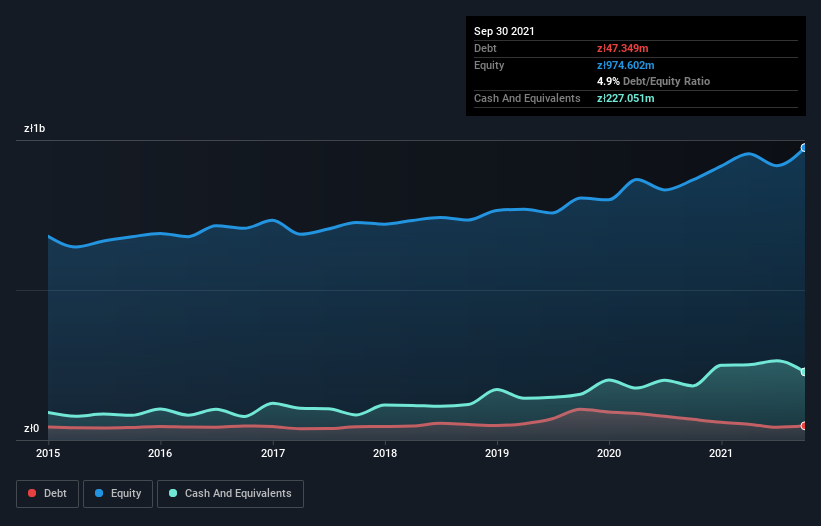Asseco South Eastern Europe (WSE:ASE) Seems To Use Debt Rather Sparingly
David Iben put it well when he said, 'Volatility is not a risk we care about. What we care about is avoiding the permanent loss of capital.' When we think about how risky a company is, we always like to look at its use of debt, since debt overload can lead to ruin. As with many other companies Asseco South Eastern Europe S.A. (WSE:ASE) makes use of debt. But the more important question is: how much risk is that debt creating?
What Risk Does Debt Bring?
Debt and other liabilities become risky for a business when it cannot easily fulfill those obligations, either with free cash flow or by raising capital at an attractive price. If things get really bad, the lenders can take control of the business. However, a more common (but still painful) scenario is that it has to raise new equity capital at a low price, thus permanently diluting shareholders. Of course, plenty of companies use debt to fund growth, without any negative consequences. The first thing to do when considering how much debt a business uses is to look at its cash and debt together.
Check out our latest analysis for Asseco South Eastern Europe
What Is Asseco South Eastern Europe's Net Debt?
The image below, which you can click on for greater detail, shows that Asseco South Eastern Europe had debt of zł47.3m at the end of September 2021, a reduction from zł68.8m over a year. However, it does have zł227.1m in cash offsetting this, leading to net cash of zł179.7m.

How Strong Is Asseco South Eastern Europe's Balance Sheet?
The latest balance sheet data shows that Asseco South Eastern Europe had liabilities of zł290.3m due within a year, and liabilities of zł91.4m falling due after that. Offsetting this, it had zł227.1m in cash and zł201.7m in receivables that were due within 12 months. So it actually has zł47.1m more liquid assets than total liabilities.
This surplus suggests that Asseco South Eastern Europe has a conservative balance sheet, and could probably eliminate its debt without much difficulty. Simply put, the fact that Asseco South Eastern Europe has more cash than debt is arguably a good indication that it can manage its debt safely.
Another good sign is that Asseco South Eastern Europe has been able to increase its EBIT by 27% in twelve months, making it easier to pay down debt. The balance sheet is clearly the area to focus on when you are analysing debt. But ultimately the future profitability of the business will decide if Asseco South Eastern Europe can strengthen its balance sheet over time. So if you're focused on the future you can check out this free report showing analyst profit forecasts.
Finally, while the tax-man may adore accounting profits, lenders only accept cold hard cash. While Asseco South Eastern Europe has net cash on its balance sheet, it's still worth taking a look at its ability to convert earnings before interest and tax (EBIT) to free cash flow, to help us understand how quickly it is building (or eroding) that cash balance. Over the last three years, Asseco South Eastern Europe actually produced more free cash flow than EBIT. That sort of strong cash generation warms our hearts like a puppy in a bumblebee suit.
Summing up
While it is always sensible to investigate a company's debt, in this case Asseco South Eastern Europe has zł179.7m in net cash and a decent-looking balance sheet. And it impressed us with free cash flow of zł203m, being 109% of its EBIT. So we don't think Asseco South Eastern Europe's use of debt is risky. There's no doubt that we learn most about debt from the balance sheet. But ultimately, every company can contain risks that exist outside of the balance sheet. Be aware that Asseco South Eastern Europe is showing 1 warning sign in our investment analysis , you should know about...
Of course, if you're the type of investor who prefers buying stocks without the burden of debt, then don't hesitate to discover our exclusive list of net cash growth stocks, today.
New: Manage All Your Stock Portfolios in One Place
We've created the ultimate portfolio companion for stock investors, and it's free.
• Connect an unlimited number of Portfolios and see your total in one currency
• Be alerted to new Warning Signs or Risks via email or mobile
• Track the Fair Value of your stocks
This article by Simply Wall St is general in nature. We provide commentary based on historical data and analyst forecasts only using an unbiased methodology and our articles are not intended to be financial advice. It does not constitute a recommendation to buy or sell any stock, and does not take account of your objectives, or your financial situation. We aim to bring you long-term focused analysis driven by fundamental data. Note that our analysis may not factor in the latest price-sensitive company announcements or qualitative material. Simply Wall St has no position in any stocks mentioned.
Have feedback on this article? Concerned about the content? Get in touch with us directly. Alternatively, email editorial-team (at) simplywallst.com.
About WSE:ASE
Asseco South Eastern Europe
Engages in the sale of its own and third-party software.
Excellent balance sheet average dividend payer.
Market Insights
Community Narratives



